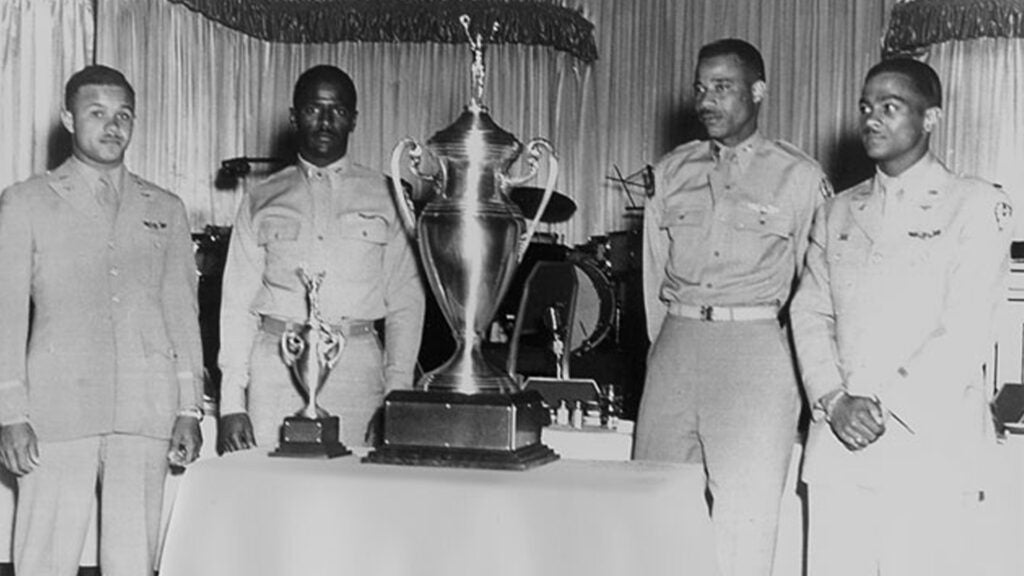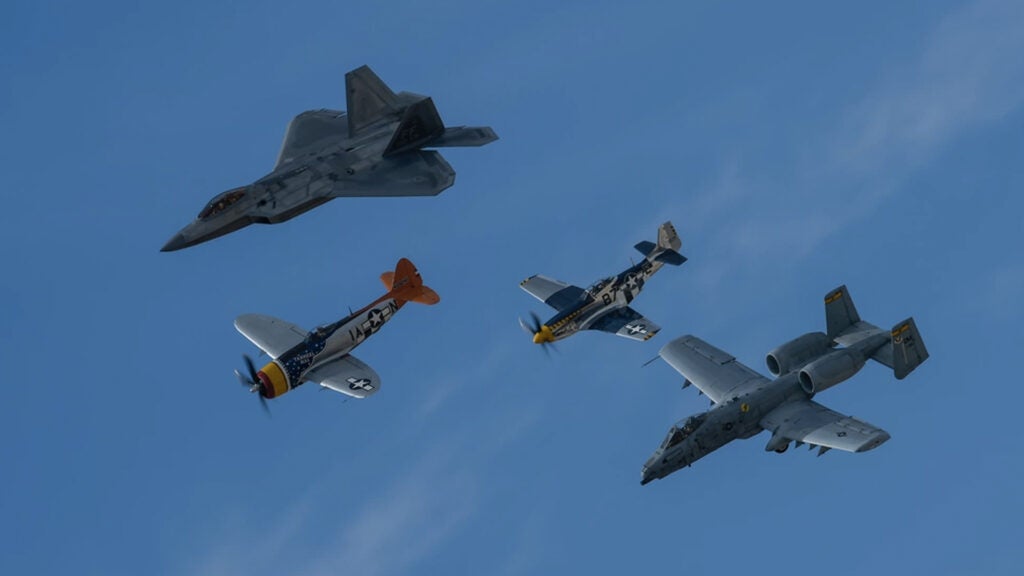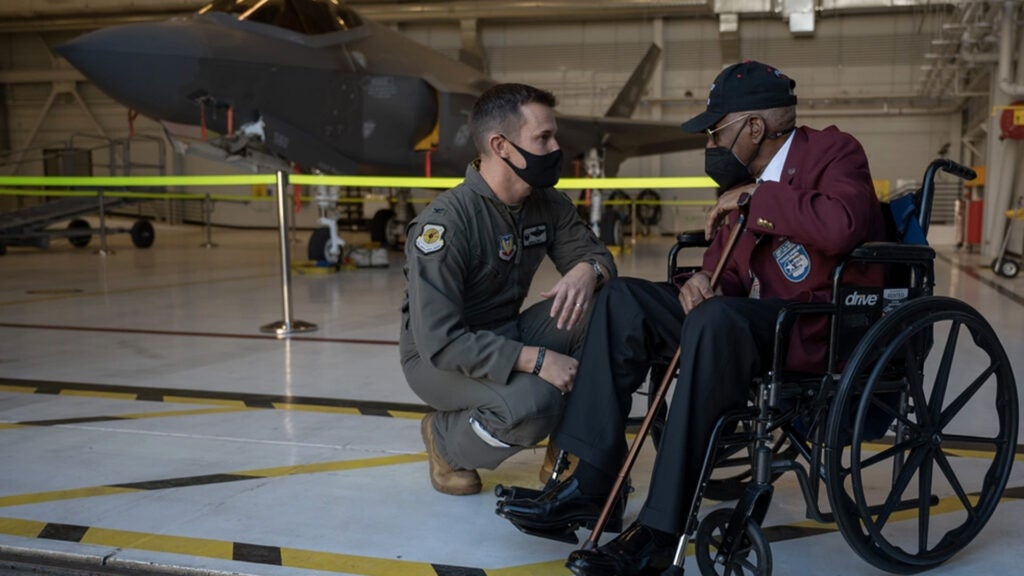Before Maverick, Iceman, “Danger Zone,” and other icons of the 1986 movie “Top Gun” made the Navy’s fighter weapons school famous, the Air Force hosted its first-ever Fighter Gunnery Meet over the desert of Las Vegas Air Force Base, now known as Nellis Air Force Base, in May 1949. Squadrons from across the two-year-old service gathered to test their mettle, but the champions were forgotten for more than half a century.
“No one expected us to win,” said one of the three winners, retired Lt. Col. James Harvey III. As a member of the 332nd Fighter Group, better known as the Tuskegee Airmen, Harvey was also one of the first Black fighter pilots in the U.S. military, and he went on to be the first Black Air Force jet pilot to fight in the Korean War.
“When it was announced that we, the 332nd, had won the trophy, the room was quiet,” Harvey recalled in a recent video about the Fighter Gunnery Meet made by the insurance group AARP. Last month, Nellis’ Air Force Weapons School, where pilots go to learn the most advanced skills on their aircraft, honored the 332nd’s win by unveiling a plaque dedicated to their achievement. The ceremony took place in a meeting room at Nellis filled with applause, which was the opposite reaction when the champions first received their trophy 73 years ago.
“There was no applause or anything like that because we weren’t supposed to win it,” Harvey said in the AARP video, which showed an archival photo of him and his teammates standing next to their trophy in 1949. “Little did I know that this was the last time the public would see the trophy for 55 years.”
[embedded content]
It’s true, after the competition ended, the trophy disappeared and the official results of the competition were recorded as “unknown,” according to the Air Force. It wasn’t until 2005 that a researcher and historian named Zellie Rainey Orr found the trophy in storage at the National Museum of the U.S. Air Force in Ohio, according to the Washington Post. It’s not clear exactly why the trophy went missing, or why the Tuskegee champs were forgotten.
As Stephan Wilkinson pointed out for Aviation History in a 2012 article about the Tuskegee Airmen, the reasons for the trophy’s disappearance are still unknown, with some believing it was a run-of-the-mill error, common with military bureaucracy, while others at the time saw it as an example of racism in the ranks, and that the Air Force couldn’t bear to admit that Black pilots had won the competition.
One of the Tuskegee Airmen who took part in the competition, retired Lt. Col. Harry Stewart, chalked it up to the former.
“There’s a story there that we’ll never know,” Stewart, who shot down three German fighters over Austria on April 1, 1945, told Aviation History. “Some people attribute it to racial bias, but I don’t feel that way myself. I think it was just a military screw-up.”
Stewart also said that he did not detect overt racism among his White competitors, despite the Air Force having integrated only the previous year.
“The white pilots were polite, cordial, not condescending,” he said. “We didn’t do too much socializing with them, though we did with our brother fighter pilots from the Ninth Air Force, the 4th Fighter Group … We had trained at some of the same fields, so we had an ongoing rapport with one another.”
Harvey remembered things differently, according to Aviation History:
“We had no contact with the white pilots,” Harvey said. “They just ignored us. Nobody talked to us, period. After the weapons meet, they had this big banquet at the Flamingo Hotel in Las Vegas. They took our pictures with the trophy, and they told us goodbye. They were having a big to-do for the winners of the meet, but we didn’t get to participate.”

No matter what happened on base, one thing is for certain: Las Vegas itself was not welcoming to the Black airmen. Despite being veterans of a decorated squadron, several of the enlisted ground crew were turned away by security guards at the Flamingo Hotel, who told the airmen it was for White people only, according to the Washington Post.
The skies over Vegas were not so prejudiced. It was “stovepipe hot” that May, Aviation History wrote, but “the weather was perfect,” said Stewart, who was a first lieutenant at the time. According to the AARP video, the three Tuskegee pilots: Stewart, Harvey, and Capt. Alva Temple (plus their alternate, 1st Lt. Halbert Alexander), faced off against the top three pilots from four other fighter groups. The pressure was high for the Black aviators.
“Before we left we had a meeting with our commander,” Gen. Benjamin Davis Jr., the first Black brigadier general in the Air Force, Harvey recalled. “He said, ‘if you don’t win, don’t come back.’”
They had five different events to show their stuff: aerial gunnery, panel strafing, dive-bombing, skip bombing, and rocket firing. Aerial gunnery consisted of shooting at a target dragged by another plane, while panel strafing involved shooting a panel on the ground. Dive bombing meant diving straight down towards the target before releasing the ordnance, while skip bombing meant flying very low, parallel to the ground before releasing so that the bomb skips into the target. Rocket firing was simple: fire rockets at the target.
But Harvey said his team was already at a disadvantage because of the older P-47 Thunderbolts they flew, which he called “obsolete.” Other pilots flew the P-51 Mustang and the F-82 Twin Mustang, a funny-looking aircraft where two P-51-style fuselages share a set of wings. Stewart did not share Harvey’s opinion of the Thunderbolt, also lovingly called ‘The Jug’ because of its large fuselage.
“It was just as good for what we were doing with it as the P-51,” he told Aviation History. In fact, the Jug would prove even better later on in the competition.

The first events were neck-and-neck. Temple did a “tremendous” job in aerial gunnery, only to be out-gunned in panel strafing by 1st Lt. William Crawford of the 82nd Fighter Group, Stewart said. “Nobody did good” on the dive-bombing day, but the 352nd surged into lead on the skip bombing day, said Harvey.
“We had a perfect score, six for six, each of us,” he told AARP.
Some of that success may have been due to the ol’ Jug. After all, the aircraft had made a name for itself as both a fighter and a close air support platform over Europe in World War II, which is why the legendary A-10 Thunderbolt II attack plane was named after it.
“We had the most fun with the skip bombing,” Harvey told Aviation History. “We’d come in with our prop tips about a foot off the ground, and the instant the target disappeared under the nose, we’d punch off the bomb. Let it go and pull up.”
The 332nd opened up the lead even more during rocket-firing the next day. The airmen felt “elated” to win, Harvey said, but the unit pride that came from the experience may have been short-lived. Soon after the competition, the 332nd was disbanded and its remaining members were sent to different units across the service. The 332nd’s ground crews were in particularly high demand, Harvey told Aviation History.
“Our ground crews were so good that when they broke our fighter group up in ’49 and scattered us to squadrons all over the world, our group commander got more requests for his maintenance people than anybody else,” said the pilot, who credited the crews for helping win the meet. “They were the best in the Air Force.”

Nearly 73 years later, Air Force pilots still duke it out in the skies over Nellis.
“We take young officers and put them through the most rigorous training we can to make them ready for combat,” Col. Daniel Lehoski, commander of the Air Force Weapons School, in an Air Force press release. “We learned this from Lt. Col. Harvey and his generation and I can’t thank him enough for the example he set for the Air Force and the weapons school.”
The ceremony last month also gave something to Harvey that many decades could not: closure.
“It’s been a long time coming, and it’s a step in the right direction,” Harvey said in the press release. “I can finally close the pages on this chapter and say, ‘mission accomplished.’”
What’s hot on Task & Purpose
Want to write for Task & Purpose? Click here. Or check out the latest stories on our homepage.
